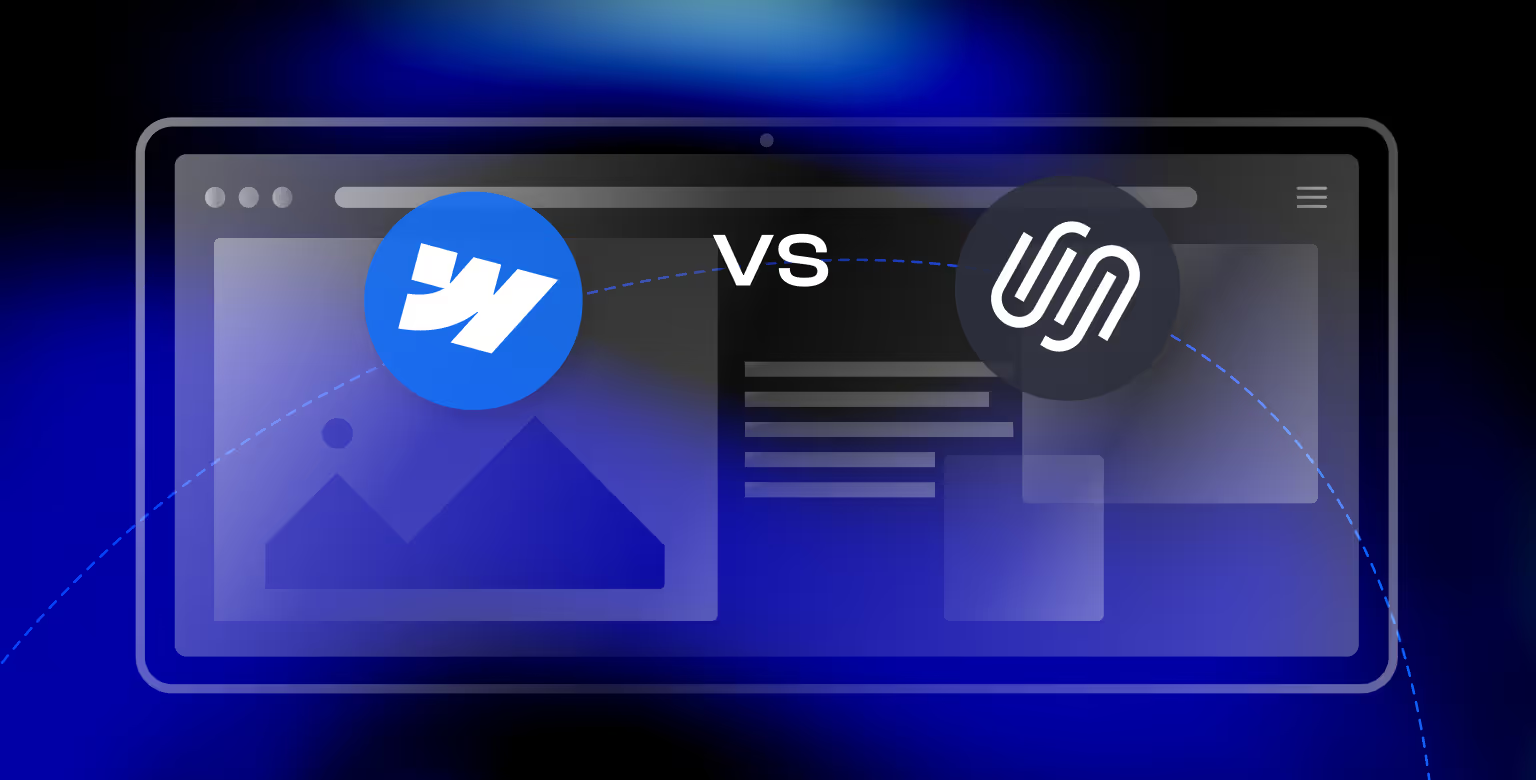When Webflow feels expensive or complex for your use case, it makes sense to compare options. This guide helps marketers, founders, and agencies get a high-level overview of Webflow’s capabilities when pinned against other platforms.
Who this guide is for
- Teams planning a new site or a migration from Webflow
- Agencies evaluating build speed, client handoff, and collaboration costs
- Founders comparing total cost of ownership, from hosting to add-ons
Introduction
Webflow is widely recognized for combining visual design with the flexibility of code, but it is not always the right fit. Some businesses find its pricing steep, especially with the company changing pricing on a yearly level, and some need capabilities that Webflow does not natively provide (yet). That is why decision makers search for alternatives.
Common reasons to consider an alternative
- Pricing: Webflow’s tiered structure and additional seat costs can strain budgets, especially for agencies managing multiple projects.
- Complexity: The interface is powerful but has a learning curve that may frustrate non-technical marketers or clients.
- Scalability: Larger organizations sometimes outgrow Webflow’s CMS item limits and workspace features, although those cases are rare.
- E‑commerce limits: Webflow Commerce remains more basic compared to specialized solutions like Shopify or Woo-Commerce.
- Client experience: Although fully dependent on the setup by developers, content editors may find the CMS editor less intuitive than alternatives designed with simplicity in mind.
This context provides a baseline for assessing which alternative fits better depending on team size, technical skill, and long-term goals.
What to Look For in a Webflow Alternative
Before comparing individual tools, it is important to know what criteria matter most. The right platform will depend on your business model, technical resources, and growth plans.
Evaluation criteria
- Ease of use: Is the interface friendly enough for non-technical team members or clients? Can they make content changes without breaking layouts?
- Design flexibility: Does the platform allow custom layouts, responsive controls, and interactions similar to Webflow’s design freedom?
- CMS capabilities: How well does it handle dynamic content such as team members, case studies, or articles? Are there limits on collections or items, and if so, what are they?
- SEO and performance: Look for clean code, fast hosting, control over metadata, and built-in options for schema, redirects and llms.txt.
- Integrations and extensibility: Check whether the platform connects easily with CRMs, analytics, marketing tools, and e-commerce extensions.
- Scalability: Consider whether the platform can handle team collaboration, multiple projects, or thousands of CMS items without hitting walls.
- Pricing and cost structure: Compare subscription tiers, seat-based pricing, hosting, and hidden costs like plugins or add-ons.
- Support and community: A strong knowledge base and active user community can shorten onboarding and troubleshooting time.
Having these criteria upfront will help filter the alternatives that meet business requirements and avoid costly migrations later.
WordPress: Open‑Source Powerhouse with Flexibility
WordPress powers over 40% of websites worldwide and is often the first alternative people consider when evaluating website development platforms. As an open-source CMS, it offers full control and ownership, but requires more management than hosted solutions.
WordPress’s Strengths
- Unlimited customization: With tens of thousands of plugins and themes, WordPress can be tailored to nearly any use case, from blogs to enterprise sites.
- Scalability: Suitable for small sites as well as large multi-language, high-traffic platforms.
- Cost control: The software itself is free. Hosting can be as low as a few dollars per month, though enterprise-grade hosting costs more.
- SEO capabilities: WordPress gives granular control over on-page SEO, sitemaps, and schema through plugins.
- Community and resources: A vast ecosystem of developers and agencies provides support, templates, and add-ons.
WordPress’s Drawbacks
- Maintenance burden: Core, theme, and plugin updates require ongoing attention. Security patches must be applied regularly.
- Performance variance: Poor hosting or bloated plugins can slow down a site. Optimization requires technical knowledge.
- Learning curve: While content editing is straightforward, creating complex layouts usually requires technical input or plugins.
Where WordPress Fits Best
WordPress is best for businesses that want complete control, are willing to manage hosting and maintenance, and value long-term scalability. Agencies with developer support can maximize its flexibility, while small teams may find it resource intensive compared to SaaS builders.
Webflow vs WordPress:
Webflow is easier to manage without technical skills, while WordPress offers full ownership and scalability if you can handle hosting and plugins. For businesses that need more control and don’t mind more maintenance, WordPress is a strong competitor.
For a full comparison, read our Webflow vs Wordpress guide.

Wix: Beginner-Friendly Website Builder
Wix is one of the most popular drag-and-drop website builders, aimed at non-technical users who want to publish quickly without coding. It has improved significantly over the years, and with Wix Studio it now offers more flexibility for professional use.
Wix’s Strengths
- Ease of use: Simple drag-and-drop interface suitable for beginners. Sites can be live in hours instead of days.
- Template library: Hundreds of pre-designed templates reduce the time needed to get started.
- App marketplace: Extend functionality with apps for forms, chat, bookings, and more.
- Wix Studio: A new environment with advanced layout and design options targeted at designers and agencies.
- Pricing flexibility: Offers a free plan with Wix branding and paid tiers at competitive rates.
Wix’s Drawbacks
- Code limitations: Advanced customizations are possible with Velo (developer platform), but less flexible compared to open systems.
- Template switching: Difficult to change templates once a site is built without redesigning from scratch.
- Scalability concerns: Suitable for small to medium sites but may not scale as efficiently for enterprise-level projects.
Where Wix Fits Best
Wix works well for small businesses, entrepreneurs, and teams prioritizing speed to market and simplicity. With Wix Studio, it is also becoming more viable for agencies handling multiple client projects where budget is a key factor.
Webflow vs Wix:
Webflow provides greater design flexibility and cleaner code, but Wix is easier for beginners and faster to launch. Teams with limited technical expertise often find Wix more approachable.
For a full comparison, read our Webflow vs Wix guide.

Squarespace: Design-Forward and Easy to Manage
Squarespace is known for its elegant templates and ease of use. It prioritizes aesthetics and simplicity, making it appealing for users who want a site that looks polished without investing in heavy customization.
Squarespace’s Strengths
- Template quality: Professionally designed themes optimized for mobile and various industries.
- Ease of editing: Section-based editor allows quick content changes with minimal learning curve.
- Built-in features: E-commerce, blogging, and basic SEO tools are included, reducing reliance on third-party apps.
- Managed hosting: All-in-one platform that handles hosting, security, and updates automatically.
Squarespace’s Drawbacks
- Limited flexibility: Customization is constrained by template structures. Truly unique designs require code injections.
- Scaling issues: Less suited for very large or complex websites with advanced functionality needs.
- Integration limits: Fewer integrations compared to WordPress or Webflow, which may restrict marketing automation.
Where Squarespace Fits Best
Squarespace is best for creative professionals, small businesses, and entrepreneurs who value design and simplicity. It is a strong alternative when speed and visual polish matter more than custom functionality.
Webflow vs Squarespace:
Both platforms offer high-quality, visually appealing templates. Webflow, however, gives more flexibility and control over customization, while Squarespace focuses on simplicity and a faster learning curve. Teams prioritizing ease of use over granular control may prefer Squarespace.
For a full comparison, read our Webflow vs Squarespace guide.

Shopify: E‑Commerce First
Shopify is the go-to choice for businesses that prioritize online sales. Unlike Webflow, which offers e-commerce as an add-on, Shopify was designed from the ground up for managing stores.
Shopify’s Strengths
- Commerce infrastructure: Provides everything needed to sell online, including inventory management, checkout, and secure payments.
- App ecosystem: Thousands of apps for marketing, logistics, customer service, and advanced store features.
- Scalability: Handles small shops to enterprise-grade stores with ease, including heavy traffic during seasonal spikes.
- Multi-channel selling: Integrated tools to sell on marketplaces, social media, and physical retail with Shopify POS.
Shopify’s Drawbacks
- Design limitations: Storefront customization is template-based, with deeper changes requiring Liquid coding.
- Higher costs: Subscription fees plus app costs and transaction fees can add up quickly.
- Not general-purpose: Best suited for e-commerce. Using Shopify as a simple marketing site is inefficient.
Where Shopify Fits Best
Shopify is ideal for founders and companies focused on product sales, whether physical or digital. It is not a direct replacement for Webflow in general marketing sites, but it outperforms Webflow in e-commerce depth and reliability.
Webflow vs Shopify:
Webflow includes basic e-commerce features, but Shopify is purpose-built for selling online at scale. If online sales are the priority, Shopify far outpaces Webflow.
For a full comparison, read our Webflow vs Shopify guide.

HubSpot CMS: Integrated Marketing and Website Management
HubSpot CMS combines website building with marketing automation and CRM, making it attractive for companies that want an all-in-one system rather than stitching multiple tools together.
HubSpot’s Strengths
- CRM integration: Seamless connection between website, sales, and marketing pipelines.
- Built-in marketing tools: Includes A/B testing, personalization, email campaigns, and lead tracking.
- Ease for marketers: Editing and managing content is straightforward, with less reliance on developers.
- Security and hosting: Enterprise-grade infrastructure with high reliability and automatic updates.
HubSpot’s Drawbacks
- Limited design freedom: Custom templates are required for unique designs, making it less flexible than Webflow or Framer.
- Pricing: Professional and enterprise tiers can be significantly more expensive than other options.
- Ecosystem lock-in: Migrating away from HubSpot can be difficult once CRM and website are deeply integrated.
Where HubSpot Fits Best
HubSpot CMS is best for B2B companies and marketing teams who prioritize lead generation and integration with CRM over full design flexibility. It works well when the website is directly tied to sales pipelines and customer journeys.
Webflow vs HubSpot CMS:
Webflow is stronger for design freedom, but HubSpot CMS integrates directly with CRM and marketing automation. Companies focused on lead generation often prefer HubSpot.
For a full comparison, read our Webflow vs Hubspot CMS guide.

Framer: Design-Centric and Interaction-Focused
Framer is built with designers in mind. Originally a prototyping tool, it evolved into a website builder that emphasizes interactivity and visual detail.
Framer’s Strengths
- Figma-like interface: Designers familiar with modern design tools can adapt quickly.
- Animation and interactions: Advanced built-in animation features create highly engaging user experiences.
- Rapid prototyping: Shortens the process from design mockups to live pages.
- Hosting included: Global CDN with automatic optimizations for speed.
Framer’s Drawbacks
- Complexity limits: Works best for landing pages, portfolios, and smaller sites, but less suitable for large-scale platforms.
- E-commerce gaps: Lacks native e-commerce features, requiring third-party solutions.
- Niche audience: Non-designers may find the interface less intuitive than Wix or Squarespace.
Where Framer Fits Best
Framer is ideal for startups, agencies, and creatives who prioritize design precision and interactive storytelling. It is a strong choice when visual engagement and speed of delivery outweigh the need for a deep CMS or large-scale site infrastructure.
Webflow vs Framer:
Webflow is broader as a full site builder, while Framer is specialized for design precision and interactions. For visually rich, interactive sites, Framer is often the better choice.
For a full comparison, read our Webflow vs Framer guide.

Divhunt: Emerging No‑Code Builder
Divhunt is a newer platform positioned as a direct competitor to Webflow. It offers advanced design controls and a generous free plan, making it attractive to teams testing modern no-code solutions.
Divhunt’s Strengths
- Visual builder: Canvas-based design experience that allows flexible layout creation.
- Advanced CMS: Supports repeater fields and nested collections, offering more flexibility than Webflow in some cases.
- Custom code support: Full access to head, CSS, and JavaScript, appealing to technical users.
- Plugin marketplace: Expands functionality without relying on embeds or external scripts.
- Pricing: Free plan includes custom domain connection, lowering entry costs.
Divhunt’s Drawbacks
- New platform: Smaller community and fewer tutorials compared to established tools.
- Feature maturity: Some advanced features are still in development.
- Adoption risk: As a newer company, long-term stability and ecosystem growth are still unproven.
Where Divhunt Fits Best
Divhunt suits agencies, freelancers, and businesses looking for a modern Webflow-style builder with fewer limitations and lower costs. It is best for early adopters comfortable with some risk in exchange for more flexibility.
Webflow vs Divhunt:
Webflow is established with a large ecosystem, while Divhunt is newer but offers fewer limits and a generous free plan. Teams open to early adoption will likely find Divhunt to be more flexible.
For a full comparison, read our Webflow vs Divhunt guide.

Ycode: Balanced No‑Code Platform
Ycode is designed to bridge the gap between ease of use and advanced capabilities. Built by the team behind Zeroqode, it aims to provide a professional-grade platform without steep learning curves or high collaboration costs.
Ycode’s Strengths
- User-friendly editor: Easier for non-technical users to manage content compared to Webflow.
- Collaboration model: Unlimited free collaborators, reducing costs for teams compared to Webflow’s seat-based pricing.
- Feature set: Includes CMS, interactions, forms, multi-language support, and custom code injection.
- Affordability: Hosting starts at around $5 per month, making it budget-friendly for multiple projects.
Ycode’s Drawbacks
- Newer ecosystem: Fewer templates and community resources than more established platforms.
- Design control trade-offs: Offers less granular control in some areas compared to Webflow’s class-based styling system.
- Enterprise readiness: Still maturing, may lack advanced compliance and enterprise-level features.
Where Ycode Fits Best
Ycode is well-suited for startups, agencies, and teams seeking a cost-effective Webflow alternative that balances power with usability. It is especially appealing for collaborative projects where Webflow’s per-seat costs are a blocker.
Webflow vs Ycode:
Webflow charges per seat for collaboration, while Ycode allows unlimited free collaborators. For teams looking to cut costs while keeping no-code flexibility, Ycode is compelling.
Conclusion
No single platform can replace Webflow for every scenario. The right choice depends on your goals, technical capacity, and long-term vision.
- Maximum control and extensibility: WordPress or Divhunt
- Ease of use for beginners: Wix or Squarespace
- E-commerce strength: Shopify
- Integrated marketing tools: HubSpot CMS
- Design precision and interactivity: Framer or Divhunt
- New-generation flexibility: Divhunt and Ycode
How to choose
- Define your top two or three priorities: budget, collaboration, or SEO.
- Shortlist two platforms that align with those priorities.
- Test them with trial sites or demos to see how they fit your workflow.
Our position at Tilipman Digital
We’re platform-agnostic by design. Our team builds in Webflow, Framer, Divhunt, and sometimes WordPress depending on the project’s requirements, timeline, and stack integration.
That said, we still choose Webflow nine times out of ten. Its visual flexibility, CMS depth, and speed of delivery consistently outweigh its drawbacks for most B2B and startup use cases. The ecosystem, stability, and client hand-off experience make it the most practical long-term foundation for our clients, especially when paired with the right custom integrations.
Conversion opportunity
Migrating to or selecting a new platform is a critical decision that affects growth and operations. Tilipman Digital supports businesses through audits, migrations, and custom builds across Webflow and its leading alternatives. Our goal is to help you choose what serves your business best, not just what’s trending.
If you’ve decided to stay with Webflow but want to improve performance, scalability, or conversion rates, our Webflow development agency helps B2B brands build faster, leaner, and more profitable sites.
Next step: Whether you’re staying on Webflow or switching platforms, reach out for a consultation. We’ll help align your platform choice with your business outcomes and technical roadmap.
Frequently Asked Questions
What is the best Webflow alternative?
The best alternative depends on your needs. WordPress is strongest for control, Shopify for e‑commerce, Framer for design precision, and Ycode or Divhunt for cost-effective no-code options.
Is there a free Webflow alternative?
Yes. Divhunt offers a free plan with custom domain connection, Framer and Wix have free tiers with subdomains, and WordPress is open-source if you arrange hosting separately.
What is the cheapest Webflow alternative?
WordPress and Ycode can be the most affordable depending on hosting and site size. Divhunt’s free plan is also attractive for freelancers and small teams.
Which Webflow alternative is easiest for beginners?
Wix and Squarespace are the simplest to learn. Ycode also provides a gentler learning curve than Webflow while keeping flexibility.
How do I migrate from Webflow to another platform?
Content can be exported from Webflow as HTML and CSV files. Rebuilding design on a new platform is usually required, with 301 redirects set up to preserve SEO. Agencies like Tilipman Digital assist with migrations to ensure smooth transitions.




